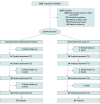Health Communication and Adherence to Noninvasive Ventilation in Chronic Hypercapnic Respiratory Failure: A Randomized Clinical Trial
- PMID: 39724376
- PMCID: PMC11672160
- DOI: 10.1001/jamanetworkopen.2024.51614
Health Communication and Adherence to Noninvasive Ventilation in Chronic Hypercapnic Respiratory Failure: A Randomized Clinical Trial
Abstract
Importance: Domiciliary noninvasive ventilation (NIV) is a standard treatment for improving health outcomes among patients with chronic hypercapnic respiratory failure (CHRF). However, poor adherence substantially limits its therapeutic effectiveness.
Objective: To determine the effect of an information-motivation-behavioral (IMB) skills-based intervention (IMB-NIV program) on NIV adherence, patient-reported health outcomes, and health service use among patients with CHRF.
Design, setting, and participants: This multisite, assessor-blinded, randomized clinical trial was conducted from January 2022 to March 2023 at respiratory clinics of 2 regional hospitals in Hong Kong among patients with CHRF who had been nonadherent to prescribed domiciliary NIV.
Interventions: The 6-week IMB-NIV program used a hybrid approach, combining in-person and telecare sessions, to provide patients with knowledge, skills, a positive attitude, and social motivation to enhance NIV adherence.
Main outcomes and measures: The primary outcome was NIV adherence data retrieved from the NIV machine. Secondary outcomes included the Pittsburgh Sleep Quality Index, Chinese Severe Respiratory Insufficiency questionnaire, venous bicarbonate (HCO3-) level, emergency department (ED) and hospital admissions, and mortality measured at baseline, program completion, and 3, 6, and 12 months.
Results: Of the 124 participants (mean [SD] age, 73.7 [7.2] years; 67 [54.0%] female), the 62 patients in the IMB-NIV group were more likely to adhere to NIV compared with the 62 patients in the usual care group at 12 months (61.3% vs 27.4%; odds ratio, 2.78; 95% CI, 1.69 to 4.55), with a greater increase noted in daily NIV use in hours at that time (B = 2.37; 95% CI, 1.44 to 3.31). A generalized estimating equation indicated significantly greater improvements in sleep quality (B = -3.63; 95% CI, -5.14 to -2.12) and health-related quality of life (β = 14.84; 95% CI, 9.18 to 20.49) at 12 months in the IMB-NIV group. The IMB-NIV group had significantly lower ED admissions (incidence rate ratio, 0.47; 95% CI, 0.26 to 0.84) and a longer time to the first ED visit (hazard ratio, 0.51; 95% CI, 0.28 to 0.95). No significant treatment effect was observed on venous HCO3- levels or hospital admissions.
Conclusions and relevance: In this randomized clinical trial, the IMB-NIV program offered a promising behavioral approach to improve NIV adherence in patients with CHRF. Its sustained positive effects on sleep quality, health-related quality of life, and ED admissions highlight its potential to optimize the therapeutic benefits of NIV.
Trial registration: ClinicalTrials.gov Identifier: NCT05008211.
Conflict of interest statement
Figures



Similar articles
-
Non-invasive ventilation for the management of acute hypercapnic respiratory failure due to exacerbation of chronic obstructive pulmonary disease.Cochrane Database Syst Rev. 2017 Jul 13;7(7):CD004104. doi: 10.1002/14651858.CD004104.pub4. Cochrane Database Syst Rev. 2017. PMID: 28702957 Free PMC article.
-
Chronic non-invasive ventilation for chronic obstructive pulmonary disease.Cochrane Database Syst Rev. 2021 Aug 9;8(8):CD002878. doi: 10.1002/14651858.CD002878.pub3. Cochrane Database Syst Rev. 2021. PMID: 34368950 Free PMC article.
-
The cost-effectiveness of domiciliary non-invasive ventilation in patients with end-stage chronic obstructive pulmonary disease: a systematic review and economic evaluation.Health Technol Assess. 2015 Oct;19(81):1-246. doi: 10.3310/hta19810. Health Technol Assess. 2015. PMID: 26470875 Free PMC article.
-
The effect of domiciliary noninvasive ventilation on clinical outcomes in stable and recently hospitalized patients with COPD: a systematic review and meta-analysis.Int J Chron Obstruct Pulmon Dis. 2016 Sep 16;11:2269-2286. doi: 10.2147/COPD.S104238. eCollection 2016. Int J Chron Obstruct Pulmon Dis. 2016. PMID: 27698560 Free PMC article.
-
Mechanical ventilation for amyotrophic lateral sclerosis/motor neuron disease.Cochrane Database Syst Rev. 2017 Oct 6;10(10):CD004427. doi: 10.1002/14651858.CD004427.pub4. Cochrane Database Syst Rev. 2017. PMID: 28982219 Free PMC article.
References
-
- Köhnlein T, Windisch W, Köhler D, et al. . Non-invasive positive pressure ventilation for the treatment of severe stable chronic obstructive pulmonary disease: a prospective, multicentre, randomised, controlled clinical trial. Lancet Respir Med. 2014;2(9):698-705. doi:10.1016/S2213-2600(14)70153-5 - DOI - PubMed
Publication types
MeSH terms
Associated data
LinkOut - more resources
Full Text Sources
Medical

